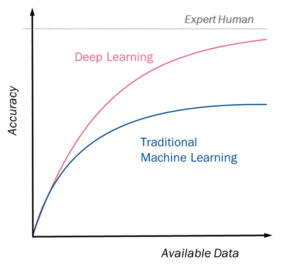
The pandemic accelerated the advancement of artificial intelligence (AI) in remote patient care. Physicians are increasingly using digital patient monitoring to better track health data, identify abnormalities, and provide patient-specific treatment — all without the need for in-person interaction. Additionally, emergency departments are employing remote monitoring solutions to allow some patients to leave the hospital sooner. These transformative technologies are leading to better outcomes for patients and reduced healthcare costs.
State of AI in healthcare
AI use cases continue to grow in healthcare, as constant learning and training of algorithms results in smarter technology as well as improved patient experiences.
Most AI applications in healthcare use “augmented intelligence,” which curates the algorithms’ output to provide clinicians with direction on “where to look” when they get the analysis. It also plays an important quality control role in delivery of the service. Augmented intelligence focuses on the technology’s assistive role, and is designed to enhance, rather than replace, human intelligence.
Consumer electronics companies, such as Apple, leverage AI to help individuals stay informed about their health. Wrist-worn devices enabled with heart rate monitoring functionality are able to notify users about unusual heart rates and provide information to share with their physicians. Physicians are also expanding their ability to monitor patients remotely with FDA-cleared technology running on AI engines. For example, solutions from Current Health provide vital sign monitoring with predictive capabilities, as well as health deterioration alerts.
In the medical grade ambulatory cardiac monitoring space, many different companies are aggressively deploying AI for EKG recordings and arrhythmia detection. Leveraging AI provides an improvement in patient outcomes over legacy technology such as rules-based or traditional machine learned algorithms (used with Holter monitors). Less sophisticated algorithms often fail to deliver high enough diagnostic yield for physicians to reach a definitive diagnosis without repeat monitoring. Devices using AI not only bring the promise of personalized medicine closer to reality, but they also further expand the ability of healthcare systems to serve populations under challenging situations, like remote areas or when in-clinic visits might not be possible.
How AI and ML are being used to monitor for cardiac care
On top of the benefits to patients, AI frees up physicians from administrative back-end work, such as sifting through and managing large datasets, and allows them to focus on using their clinical skills for patient care.
AI can identify patterns humans cannot. For example, the average heart beats about 1.5 million times over two weeks, and physicians might have to identify a six second time period which is determinant of a clinical outcome. Finding what’s clinically meaningful can be a needle in the haystack type of problem, and AI ensures higher accuracy at scale.
To reach this level of reliability, providers, data science teams, and AI need clean data, and large amounts of it. This expansion of data requires sophisticated means of analysis, which is possible through machine learned and deep learned algorithms. In the last decade, deep learning, a subset of machine learning, has enabled the development of algorithms that have matched human performance in a number of scientific areas. Unlike more traditional machine learning approaches that predict outcomes based on human-curated features, deep learned algorithms, using artificial neural networks, have the advantage of automatically learning relevant features from raw data. As a result, they use large amounts of annotated examples/data and significant computational capabilities to build complex models, able to predict the correct outcome of new inputs with very high accuracy.
Both machine learning and deep learning approaches require heavy oversight from the FDA and 510(K) clearances prior to deploying in the healthcare space. This clearance demonstrates that devices using this technology are safe and effective. With the increasing pace of algorithm innovation and data volume creation, regulatory agencies are proposing frameworks that will harmonize best practices and regulatory requirements while allowing for a continuous improvement of the devices at a faster rate compared to the past. Such efforts are evident by FDA’s release of the AI/ML-Based Software as a Medical Device Action Plan in January of 2021, followed by the Good Machine Learning Practice for Medical Device Development: Guiding Principles that was developed in conjunction with Health Canada and the United Kingdom’s Medicines and Healthcare products Regulatory Agency (MHRA).
Utilizing advanced algorithms and large amounts of data, deep learning has achieved expert, human-level performance in many applications:

The next stage of AI innovation in healthcare
We’re just at the beginning of what AI can do in healthcare. Last year, the Biden administration created an AI task force to provide easier access to government data and expand access to critical resources and educational tools that will continue to spur AI innovation. This act builds on 2020 legislation and includes a budget of $250 million for a period of five years.
With this nationwide spotlight on AI innovation and increased funding, the next frontier of AI and wearables will be expanded use of predictive capabilities: moving the paradigm of clinical insight from retrospective reporting to predicting risks about future conditions. In the healthcare sector, the key will be deciding which patient population to monitor and when by identifying and analyzing health risks and ensuring patients get proper preventative medical care.
AI innovation is changing healthcare delivery. It can enhance the patient experience, reduce administrative burden for patients, physicians and care teams, and likely improve health outcomes. Further investment and technological advancements will unquestionably revolutionize remote patient care as we know it. The recent momentum, due to the pandemic, of remote care adoption and AI utilization will continue as the healthcare system evolves to meet ongoing and future challenges.
Photo: ismagilov, Getty Images








